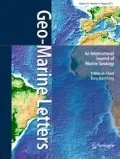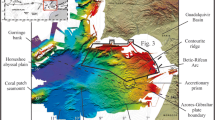Abstract
The first map of the sea bed morphology and sedimentary features within the RMSTitanic search area is proposed from the interpretation of SAR side-scan sonar images. Downslope sedimentary features such as erosional furrows and crown scarps constitute a 7 km wide instability corridor. A large field (15 km2) of asymmetrical sediment waves indicating a downslope transport is identified. Current-induced features corresponding to associated sand ribbons and barchan dunes resulting from the Western Boundary Undercurrent action are mapped. The morphology of theTitanic Canyon is also precised from the SAR images. Finally, the origin of the sea bed features is discussed in an attempt to link each bed form to a sedimentary process.
Similar content being viewed by others
References
Alam M, Piper DJW (1981) Detrital mineralogy and petrology of deep-water continental margin sediments off Newfoundland. Canadian Journal Earth Sciences 18/8:1,336–1,345
Alam M (1987) Late Quaternary plume, nepheloid and turbidite sedimentation and effect of the gulf stream near the tail of the Grands Banks, Newfoundland. Marine Geology 74:277–290
Augustin JM (1986) Logiciel de traitement des images acoustiques des sonar lateraux. Rapport IFREMER
Ballard RD (1986) A long last look at theTitanic. National Geographic, Dec. 1986
Canadian Hydrographic Service Department of Fisheries and Oceans (1987) Newfoundland Ridge Bathymetry, map NK 22-B
Cochonat P, Ollier G (1987) Environnement sedimentaire et morphologie du glacis continental au sud-est de Terre-Neuve. IAS regional Meeting, Tunis
Cochonat P, Ollier G (1987) Interprétation Géologique des Images “SAR” Données de l'opération Titanic. Rapports scientifiques et techniques de l' Institut Français de recherche pour l'exploitation de la mer (IFREMER) No. 4
D'heilly P, Millot C, Monaco A, Got H (1988) Hydrodynamic study of the Petit Rhône canyon. Deep-Sea Research 35/3:465–471
Farcy A, Voisset M (1985) Acoustic imagery of sea floor. Ocean 85, San Diego 1005–1012
Flood RD (1983) Classification of sedimentary furrows and a model for furrows initiation and evolution. Geological Society America Bulletin 94:630–639
Fofonoff NP, Hendry RM (1985) Current variability near the southeast Newfoundland Ridge. American Meteorological Society 15:963–984
Kenyon NH (1970) Sand ribbons of European tidal seas. Marine Geology 9:25–39
Pastouret L, Auffret GA, Hoffert M, Melguen M, Needham HD, Latouche C (1974) Sédimentation sur la Ride de Terre-Neuve. Canadian Journal Earth Sciences 12:1019–1035
Piper DJW, Shor AN, Farre JA, O'Connell S, Jacobi R (1985) Sediment slides and turbidity currents on the Laurentian Fan: side-scan sonar investigations near the epicenter of the 1929 Grand Banks earthquake. Geology 13:538–541
Ryan PR (1986) TheTitanic revisited. Oceanus 29, no. 3
Ryan WBF (1982) Imaging of submarine landslides with side-scan sonar. Symposium, Nato, 1982
Ryan WBF (1983) The use of mid-range side-looking sonar to locate the wreck of theTitanic. Subtech 83, Paper 11.4
Ryan WBF (1986)Titanic Canyon: an example of entrenched drainage on the upper continental rise. SEPM Annual Midyear Meeting, Raleigh, North Carolina
Schnitker D (1979) The deep water of western North Atlantic during the past 24,000 years, and the reinitiation of the Western Boundary Undercurrent. Marine Micropaleontology 4:265–280
Shanmugam G, Moiola RJ (1982) Eustatic control of turbidites and winnowed turbidites. Geology 10:231–235
Stow DAV (1979) Contourites: their recognition in modern and ancient sediments. Earth Sciences Reviews 14:251–291
Stow DAV (1985) Deep-sea clastics: where are we and where are we going? Geological Society of London, Special Publications: 67–93
Uchupi E, Hays H (1981) Map of the North Atlantic, Woods Hole Oceanographic Institution
Uchupi E, Muck MT, Ballard RD (1988) The geology of theTitanic site and vicinity. Deep-Sea Research 35/7:1,093–1,110
Author information
Authors and Affiliations
Rights and permissions
About this article
Cite this article
Cochonat, P., Ollier, G. & Michel, J.L. Evidence for slope instability and current-induced sediment transport, the RMSTitanic wreck search area, Newfoundland rise. Geo-Marine Letters 9, 145–152 (1989). https://doi.org/10.1007/BF02431041
Received:
Revised:
Issue Date:
DOI: https://doi.org/10.1007/BF02431041




